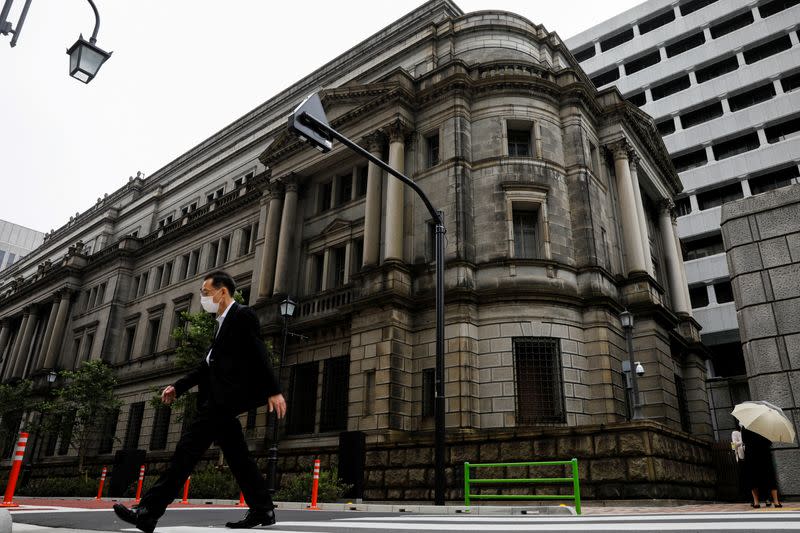BOJ fine-tunes massive stimulus in long drive to boost prices

By Leika Kihara and Tetsushi Kajimoto
TOKYO (Reuters) - The Bank of Japan slightly loosened its grip on long-term interest rates on Friday and laid the groundwork to taper its huge asset purchases, as part of steps to make its stimulus sustainable enough to weather a prolonged battle to fire up inflation.
In a review of its policy tools announced after a two-day meeting, the BOJ said it would allow long-term interest rates to move up and down by 0.25% around its 0% target, instead of by the current implicit band of 0.2%.
To give itself more room to wind down its massive stimulus, the central bank also removed an explicit guidance to buy exchange-traded funds (ETF) at an annual pace of roughly 6 trillion yen ($55.21 billion).
Instead of buying at a set pace, the BOJ said it would step in only when markets destabilise under a 12-trillion-yen ceiling set last year when the initial COVID-19 hit jolted stock prices.
Governor Haruhiko Kuroda brushed aside the view the moves were a prelude to a full-blown exit from years of ultra-easy policy, stressing that the tweaks instead would make his stimulus sustainable and more effective.
"We won't tolerate yield fluctuations that would have an impact on our monetary easing," Kuroda told a briefing. "We absolutely need to make sure the effect of our monetary easing isn't hurt. We clarified that stance with our new guidance."
The BOJ also created a scheme similar to that of the European Central Bank under which it pays up to 0.2% interest to financial institutions that tap its loan programmes.
As widely expected, it maintained its target of -0.1% for short-term rates and 0% for the 10-year bond yield under its yield curve control (YCC) policy.
NO GAME CHANGER
The moves were mostly within market expectations, as BOJ officials have been dropping hints that they will allow yields to fluctuate more to breathe life back into a market made dormant by the bank's dominance.
Among the few surprises was the BOJ's decision to contain its purchases of ETFs to those linked to the broader Tokyo stock index Topix, which sent the Nikkei average down and the Topix surging to a 30-year high.
"The Bank of Japan's policy review today contained various nudges to policy levers but ultimately marked neither a tightening nor an easing of policy," Capital Economics wrote in a research note, describing the moves as a "rearrangement of furniture" ahead of a long period of status quo.
While the initial focus of the review was to let market forces drive asset prices more, Kuroda stressed the near-term priority was to keep borrowing costs stably low to support an economy hit by the pandemic.
Indeed, the BOJ said it will not apply the rule rigidly when yields move below the band temporarily, but step in forcefully with unlimited bond purchases to prevent sharp rise in yields.
The conflicting goals made the BOJ's tweaks so modest it will barely revitalise markets, some analysts say.
"It's a very minor change. The difference between 0.25% and 0.2% is quite small," said Masaaki Kanno, chief economist at Sony Financial Holdings in Tokyo. "There's a long way to go before we even get close to 2% inflation," he added.
In an effort to dispel market views it has run out of ammunition to ramp up stimulus, the central bank also took steps to ease the strain on financial institutions from negative rates.
Specifically, the BOJ decided to pay interest to financial institutions that borrow from its various lending schemes in hope the incentives would prod them to boost lending.
"Some people say the BOJ cannot deepen negative rates because of the side-effects," Kuroda said. "That's not true. I don't think it's impossible to deepen negative rates."
Many analysts, however, remained unconvinced the measures announced on Friday would help the BOJ achieve its price goal.
"In practical terms, there is not much for the Japanese economy in these policy tweaks," said Joseph Capurso, currency analyst at Commonwealth Bank of Australia.
"One thing that the central bank did do is they made some tweaks to their various bank lending facilities. But these are just tweaks and I don't think that they're going to change the trajectory of the Japanese economy."
($1 = 108.6700 yen)
(Reporting by Leika Kihara and Tetsushi Kajimoto; Additional reporting by Kaori Kaneko and Daniel Leussink; Editing by Shri Navaratnam, Sam Holmes and Kim Coghill)

